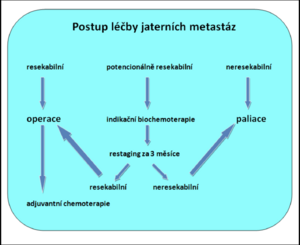Treatment of liver metastases in colorectal cancer
The Czech Republic ranks first in the world in the incidence of colorectal cancer. Despite screening programs, there are still a large number of patients who have distant, especially hepatic, metastases.
In most other malignancies (breast tumors, bronchogenic carcinoma), liver metastases are a sign of a highly advanced finding that is no longer resolved by any radical (curative) resection, but this does not apply to colorectal carcinoma. In fact , curative resections of cancer can be performed in 10-20% of colorectal cancer patients who have liver metastases[1]. Therefore, their treatment should receive increased attention. The result is 40% five-year patient survival[1][2].

|
CT: metastatické postižení jater |
Types of metastases[edit | edit source]
According to the time of occurrence, we distinguish metastases:
- synchronous - diagnosed with primary tumor;
- metachronous - diagnosed only after resection of the primary tumor.
In the case of synchronous metastases, resection at the same time together with tumor and lymphadenectomy is recommended.
Therapy procedure[edit | edit source]
The following are important for the treatment procedure:
- the overall biological status of the patient and staging cancer;
- liver function.
Resectable liver metastases[edit | edit source]
A patient with resectable metastases can be operated on immediately and then undergo adjuvant chemotherapy, or first undergo neoadjuvant chemotherapy, then resection and adjuvant treatment.
Potentially resectable metastases[edit | edit source]
Patients with potentially resectable metastases first undergo indicative biochemotherapy, after 3 months of restaging, when a final decision is made as to whether they are resectable or not.
Unresectable liver metastases[edit | edit source]
The only possible procedure is palliative chemoradiotherapy.
Chemotherapy[edit | edit source]
The response of liver metastases to chemotherapy is quite high, in 50–60% of cases they regress or even disappear (4-7%) on CT examination. The disadvantage is the formation of vascular lesions after some preparations:
- blue liver - sinusoidal obstruction syndrome (SOS) after oxaliplatin;
- yellow liver - liver steatosis (CASH) after irinotecan.
Bevacizumab may impair the liver's ability to regenerate.
Surgical resection[edit | edit source]
Prior to liver resection, CT volume therapy must be performed to estimate the amount of liver tissue remaining. In general, at least 20% of the functional tissue must be maintained in otherwise healthy livers and up to 40% in affected livers (blue or yellow livers).
Resections of liver metastases can be anatomical (segmentectomy) or non-anatomical (metastatectomy). Currently, non-anatomical resections are preferred because they are performance-saving liver tissue. It is advantageous to save liver tissue in case of further metachronous metastases and other possible resections.
Anatomical resections[edit | edit source]
Anatomical resections include segmentectomy (the liver has 8 segments) and lobectomy. At present, they are not preferred because they are more radical performances.
Non - anatomical resections[edit | edit source]
NAR (non-anatomical resection) is a performance-saving parenchyma. Perioperative sonography is necessary to clarify the location of metastases during surgery. Previously, a 1-2 cm border of healthy parenchyma around the resected metastasis was required. This is already being abandoned, less is enough.

